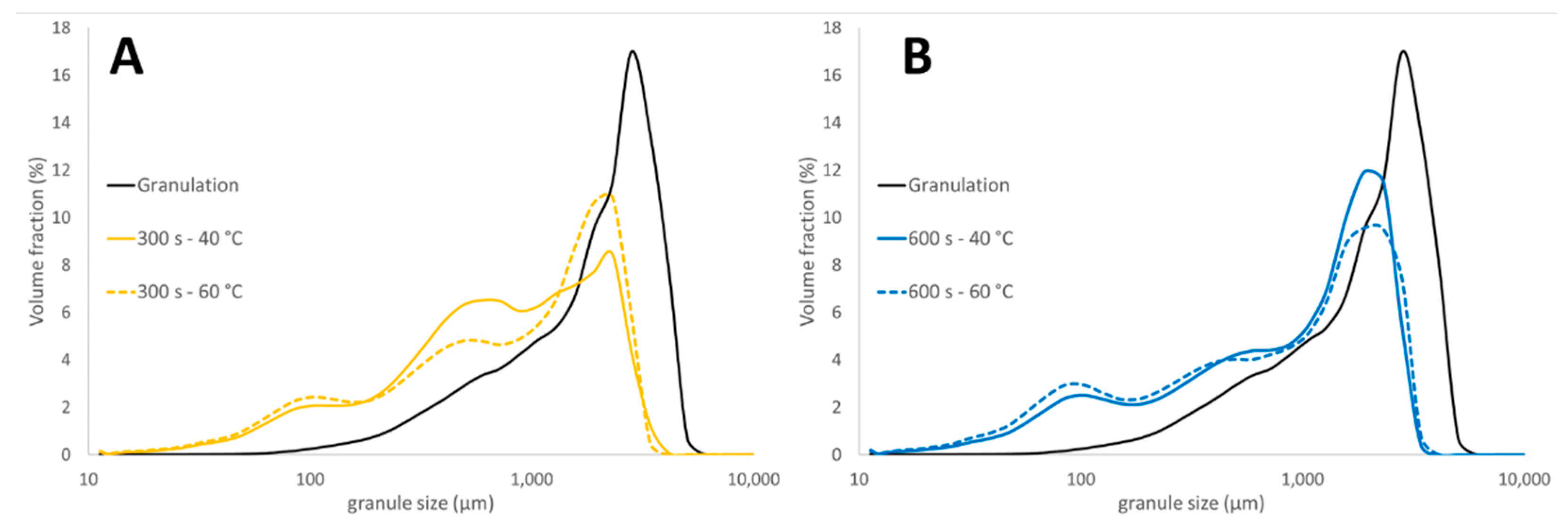The Influence of Equipment Design and Process Parameters on Granule Breakage in a Semi-Continuous Fluid Bed Dryer after Continuous Twin-Screw Wet Granulation

The drying unit of a continuous from-powder-to-tablet manufacturing line based on twin-screw granulation (TSG) is a crucial intermediate process step to achieve the desired tablet quality. Understanding the size reduction of pharmaceutical granules before, during, and after the fluid bed drying process is, however, still lacking. A first major goal was to investigate the breakage and attrition phenomena during transport of wet and dry granules, the filling phase, and drying phase on a ConsiGma-25 system (C25). Pneumatic transport of the wet granules after TSG towards the dryer induced extensive breakage, whereas the turbulent filling and drying phase of the drying cells caused rather moderate breakage and attrition. Subsequently, the dry transfer line was responsible for additional extensive breakage and attrition. The second major goal was to compare the influence of drying air temperature and drying time on granule size and moisture content for granules processed with a commercial-scale ConsiGma-25 system and with the R&D-scale ConsiGma-1 (C1) system. Generally, the granule quality obtained after drying with C1 was not predictive for the C25, making it challenging during process development with the C1 to obtain representative granules for the C25.
Download the full article here: The Influence of Equipment Design and Process Parameters on Granule Breakage in a Semi-Continuous Fluid Bed Dryer after Continuous Twin-Screw Wet Granulation
or continue reading here: Ryckaert, A.; Ghijs, M.; Portier, C.; Djuric, D.; Funke, A.; Vervaet, C.; De Beer, T. The Influence of Equipment Design and Process Parameters on Granule Breakage in a Semi-Continuous Fluid Bed Dryer after Continuous Twin-Screw Wet Granulation. Pharmaceutics 2021, 13, 293. https://doi.org/10.3390/pharmaceutics13020293
Materials
The formulation under study consisted of a low drug-loaded, poorly soluble, and poorly wettable API (BCS class II), a large content of α-lactose monohydrate (Pharmatose 200, DFE Pharma, Goch, Germany), microcrystalline cellulose (MCC; Avicel PH101, FMC biopolymer, Philadelphia, PA, USA), hydroxypropyl methylcellulose (HPMC; Methocel E5, Dow, Midland, MI, USA), croscarmellose sodium (Ac-Di-Sol, FMC, Philadelphia, Pennsylvania, MI, USA) and sodium dodecyl sulphate (Kolliphor SLS, BASF, Ludwighafen, Germany).
Conclusions
In this study, it was possible to elucidate where and to what extent breakage and attrition occurred along the length of the C25 line. It was shown that breakage occurred in the wet transfer line because solid intra-granular bonds were not yet formed. Furthermore, breakage and attrition during drying were very limited, whereas the pneumatic transfer via the dry transfer line caused extensive breakage as the drying cells were powerfully emptied. Since fixed granulation parameters were applied on the same formulation, the extent of breakage presumably differs when different parameters and different raw materials are applied. However, it is suggested that similar breakage and attrition phenomena would occur at the studied locations, regardless of the formulation.
This study showed that the moisture content influenced the final granule size on C25, as it co-determines granule strength. It was found that an optimal moisture content range for granule strength exists, and granules were found to be more prone to breakage when having a moisture content below and above the range of 1–3% due to drying-induced thermal stresses and incomplete solid bond formation, respectively. Moreover, the current study also demonstrated that the residual moisture content was generally lower for identical process parameters for granules processed on C25 because heat was transferred by convection and conduction from the surrounding empty cells. The final particle size of granules processed on C1 differed substantially, making it difficult during process development to obtain a granule quality that is representative for the C25. Overall, this study provided an enhanced understanding in the breakage behavior during fluid bed drying, which is important in process and formulation optimization and process control. Further, the obtained results are useful in the development of a generic drying model or a flowsheet model used for the simulation of granule size.

